Table of Contents
Burette Stand
A neat burette table is shown in Fig. 25. It is 32 inches high, 4 feet long, and 2½ feet wide. It has a shallow cupboard below and a narrow drawer. The bottom of the drawer extends only half way across the table, so that it does not interfere with the tubes leading from the burettes to the bottles. The
burette holder illustrated is merely a wooden frame. It is of the form shown, having holes bored through where the burettes are to go. The burettes themselves are held in place by a wedge, as illustrated in Fig. 26. In place of the frame shown, iron rods may be passed through holes in the table and fastened to the upper framework of the cupboard. The burette is then held in place by the ordinary burette clamps, over the jaws of which should be slipped a piece of rubber tubing to give them a firm grip. Or, since this tubing is apt to rot and stick to the burette, a piece of felt may be glued inside the jaws for this burette. Since burettes are always held in an upright position, the clamps with strong springs to close the jaws are more convenient than the adjustable ones eloped by a thumbscrew, since it is easier to get the burettes in and out for cleaning, etc. On the other hand, they do not last as long because the springs break.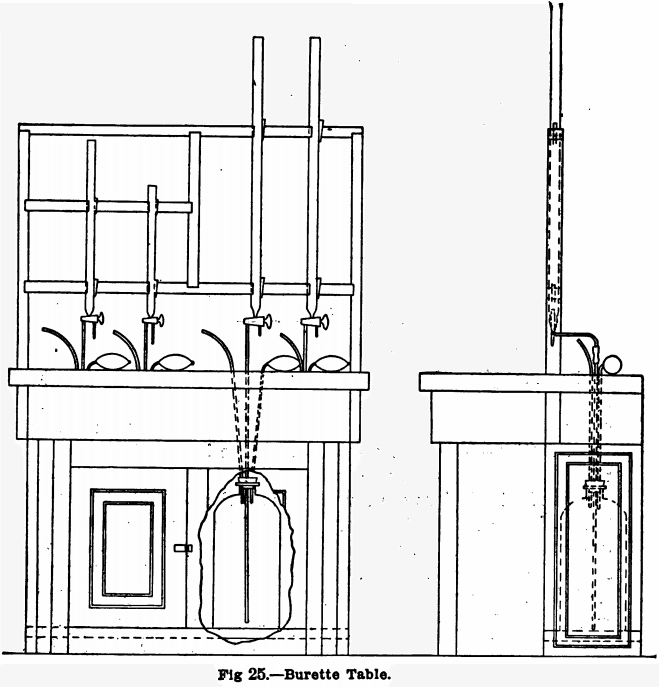
Burettes
The most convenient burette is the one having a three way stop cock and side tube for filling. In the table shown, the standard solutions are forced up into the burettes from the bottles in the cupboard below, by use of an atomizer bulb. In using, enough solution should be forced into the burette to fill it above the zero point. The excess is then run back into the bottle below. The bottle holding the solution should be provided with a three hole rubber stopper. Through one of these stoppers the tube leading to the burette passes. This tube, should, of course, reach nearly to the bottom of the bottle. The second and third holes are provided with short pieces of tubing reaching just inside the bottle. One of these tubes is attached to the atomizer bulb and the other to a piece of rubber tubing passing through a hole in the table top and extending about three or four inches above the latter. Instead of a three-hole rubber stopper, a two-hole one may be used and a Y-tube inserted in one of the holes. The atomizer bulb is then to be attached to one of the branches of the “Y” and the rubber tube to the other.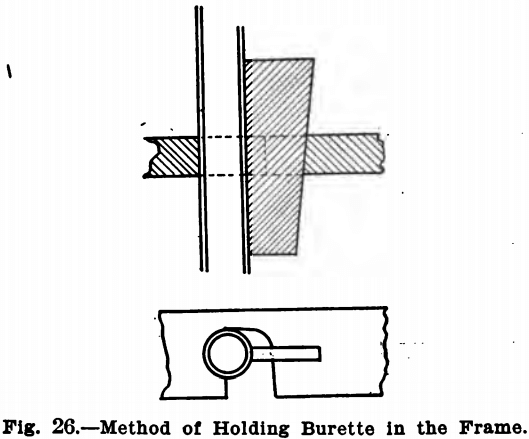
In forcing the solution up, the stop cock of the burette is turned to make connection with the bottle, the rubber tubing is pinched with the left hand and the atomizer bulb is worked with the right. When the solution reaches a certain point in the burette, determined by practice (usually the 25 or 30 c. c. mark), the pressure in the bottle is sufficient to fill the burette. At this point, the right band is withdrawn from the atomizer bulb and placed on the stop cock. As soon as the solution passes the zero point, the connection between the bottle and the burette is cut off by the stop cock. All this time the rubber tube has been kept tightly closed by pinching between the thumb and forefinger of the left hand. This is now released and the pressure in the bottle relieved. The excess of solution in the burette can then be run back into the bottle. This same form of burette can also be obtained in a very convenient form, with an automatic zero point and an overflow reservoir similar to that of the pipette illustrated in Fig. 29, from Eimer & Amend, 18th St. and 3d Ave., New York. These latter are very useful, as they require no adjusting to the zero point when filling and consequently save time.
Instead of forcing the solution up from a bottle in a cupboard below, if permanganate, bichromate, iodine, and other solutions attacking rubber tubing or decomposed by the light are not used, a shelf may be placed on the wall back of the table and the solutions run down into the bottle. If, however, standard solutions attacking rubber are used, the cupboard below the table is the thing, since in the shelf arrangement the solution is in contact with the rubber tube used to join the burette tube below to the tube leading from the bottle; hence it soon eats a hole in the latter. If this happens at night, the whole bottle of standard solution will probably leak out, and an eight-liter bottle of permanganate would make a mess, in any event; while, if the laboratory was located on the second floor, it would probably damage the ceiling of the room below. Where the solutions do not attack rubber it is, of course, more convenient to have the bottles on a shelf and run solutions down into the burettes by a siphon tube. The shelf, however, must be placed above the zero point of the burettes, in order to bring the solutions to the zero point when the bottles are nearly empty. When standard solutions are decomposed by light, they may be kept in bottles painted black with asphalt paint, or the bottles may be provided with a hood or bag cover, of heavy black cloth. When standard alkali and other solutions attacking glass are used, the burette should be of the old style Mohr’s form, with rubber connections and attachments for filling from the side.
Automatic Zero Burette
The ordinary form of burette may be made to answer as a zero point burette by the arrangement shown in Fig. 27. This consists in placing the top of the bottle holding the standard solution below the zero point of the burette. The tube leading from the former to the latter is then run down into the burette, level with, or a little above the zero point. This arrangement will siphon off the excess of solution in the burette, to the zero point, after a few adjustments and trials of the tube in different positions. The writer has at times experienced more or less trouble with this form of burette from the drop which collects on the end of the tube falling into the burette. This may be obviated by having the siphon tube drain into the bottle as much as possible and to this end it should be bent as shown in the cut. The end leading into the burette should also be drawn very slightly towards a point. This latter will hold the drop. It is usually hard to get a rubber stopper small enough to go into the tube and with a large enough hole to admit the tubing, so as all that is needed is something to hold the tube in position an ordinary cork can be used. A few V-shaped grooves should be cut lengthwise down its sides to admit air in and out of the burette.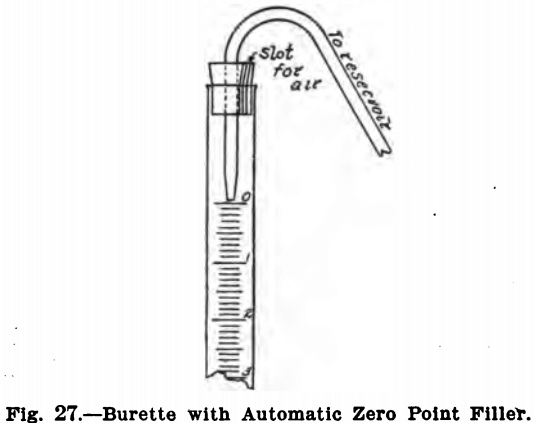
Appliances to Aid in Reading the Burette
For aiding the operator in reading the burette, various appliances have been suggested. For colored solutions such as permanganate, nothing is needed, but for colorless ones floats are sometimes used. A new burette, designed by Schellbach, has recently been placed on the market and may be obtained from a number of dealers in chemical apparatus. This burette has a blue enameled line, with a white enameled background, running lengthwise down the burette. At the level of the solution, this line presents the appearance of an X and the level is taken as the point where the two V’s come together.
Burettes having a white enameled background for use with colored solutions can also be obtained. A card having a piece of black paper pasted across its lower half, or having this part blackened, will aid in reading colorless solutions in an ordinary clear glass burette. If held with the line of division between the black and white, about an eighth of an inch below the surface of the liquid, and the eye brought on a level with it, the meniscus can then be seen by transmitted light, bounded below by a sharply defined black line.
Caps for Burettes
If the top of the burette is open it should be closed by a small-glass cap, slipping loosely over it. One can be easily made from a test tube, as follows: Select a tube which slides over the burette top and mark it about one and a half inches from the closed end with a sharp file. Wrap two strips of wet filter paper around the tube, one a little above and one a little below the mark and about one-eighth inch apart. Direct the point of a small blowpipe flame against this opening between the two strips and revolve the tube. A crack will start and follow the flame around the tube. This is a simple way of cutting glass cylinders or tubes, and a five-pound bottle may be turned into a waste jar for the burette table in the same way; scratching it, wrapping wet newspaper around it, and cracking it with a flame. The writer has found this way much more satisfactory than the methods usually recommended for the purpose.
Portable Burettes and Solutions
Burettes mounted on the bottles containing the solutions with which they are to be filled are sometimes used and will be found useful when only a few titrations are to be made and these few not very often. They are usually fitted with automatic zero point. The forms designed by Squibb and Knopler are described in almost every catalogue of chemical apparatus. The great disadvantage of these arrangements is the small size of the bottles, which is usually two liters capacity, and of the burette, which is never larger than 50 c. c. If made larger the bottle is too heavy to move about, and the burette too long.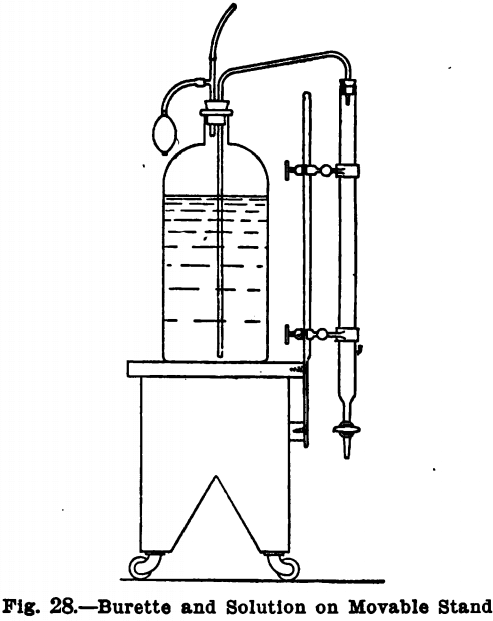
When space is limited, a burette and bottle mounted on a stand provided with rollers will prove handy, as it can be pushed back out of the way when not needed. Fig. 28 shows such an apparatus. Its construction is evident from the illustration. It consists of a stand, mounted on rollers, to the front of which is fastened an iron rod, two feet long and ¼ or 5-16 inch in diameter. The lower end of the rod is flattened and through the flattened end are bored two small holes. Screws through these holes fasten the rod to the stand. The burette is then clamped to the rod with jaw clamps and the solution is forced up either by a bulb or suction. The tube leading from the bottle to the burette is fixed to siphon off the excess to zero as described previously. The bottle should be kept in place on the stand by three small blocks nailed on top of the latter close to the bottle; for, if the bottle slides around, it will break the tube leading to the burette. Of course, any form of burette, either with or without automatic zero point, may be attached to the stand, and if the permanganate, bichromate, etc., are to be used with the apparatus, the bottle should be painted black, etc.
Pipettes
For rapidly delivering known volumes of solutions the automatic pipette, shown in Fig. 29, will be found very useful. The bottle acting as a reservoir should be placed upon a shelf and the solution run down into the pipette. Since these pipettes are light compared with burettes, they can be joined directly on to the siphon tube leading from the reservoir by fusion and used for solutions, such as ammonium molybdate in nitric acid, which attack rubber rapidly. The siphon tube should be made of heavy walled glass tubing so as to resist breakage. The pipette may be fastened to a stand and the stand may be mounted on rollers, or not. Or the pipette may be mounted on the frame of the burette table. Before fastening the pipette to the stand or frame, the bottle should be placed on the shelf and moved about until the pipette is against its support. The pipette may then be fastened to the support by wire or a narrow thin brass band or spring.
Caustic soda and other solutions which absorb carbon dioxide should be protected from the air, or the air entering the bottle should be freed from the carbon dioxide by passing it over an absorbent. One of the simplest methods is to place a layer of kerosene on top of the solution, effectually protecting it from the air. Another method is to pass the air through a tube containing soda lime, which absorbs carbon dioxide. The soda lime tube may be stuck through one hole of a doubly perforated stopper, the siphon tube passing through the other.
Occasionally burettes will not run clean and small drops will adhere to their sides causing the readings to be too low. To remedy this, allow a weak solution of chromic acid to stand in the burette for several hours. To prepare this solution, add about 25 grams of potassium bichromate to 150 c. c. of water and 15 c. c. of concentrated sulphuric acid. This solution will not attack the rubber tube of a Mohr’s burette. Vaseline is probably as good a lubricant as can be found for the burette cocks.
Indicator Bottles, Spot Plates, Etc
Indicators showing the end point of titrations should be kept in bottles provided with droppers. Any catalogue of chemical supplies will show several different forms, of which Schuster’s, provided with a ground glass
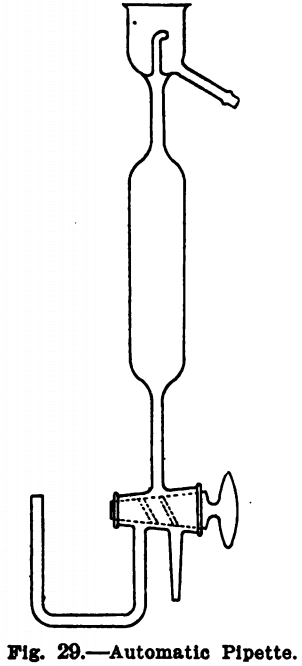
stopper, will be found convenient. A bottle through the cork of which a medicine dropper is inserted may also be used; or, in place of the rubber-bulb dropper, a piece of short glass tubing (5 in.) may be drawn out to a point at one end and blown into a bulb at the other. The warmth of the fingers placed on the bulb causes the air in the latter to expand, forcing a drop or two of the indicator out of the other end.
Spot plates of porcelain will be needed where outside indicators are used. These are glazed and may be purchased either with or without cavities. These latter plates are the most convenient, as the drops are held in depressions and do not run together. A plate 5 7/8 x 7 inches, with 30 cavities, will be found a good size for bichromate and ferrocyanide titrations. A spot plate may be made by pouring melted paraffine into a dinner plate and allowing it to cool. This plate may be easily cleaned by washing off with a stream of hot water from a wash bottle.
Porcelain plates are also used upon which to set beakers, flasks, etc., in order to observe the color changes during titration. Flat, square plates may be purchased for this purpose, or dinner plates or saucers may be used. Where titrations are made at night, the following device is said to be useful: A hole 6 inches square is cut in the table just below the burette, a ground glass plate is fitted over this and under the glass is placed an incandescent lamp with a white reflector.
Where solutions have to be titrated while boiling, a small electric stove or hot plate is said to be exceedingly convenient.
